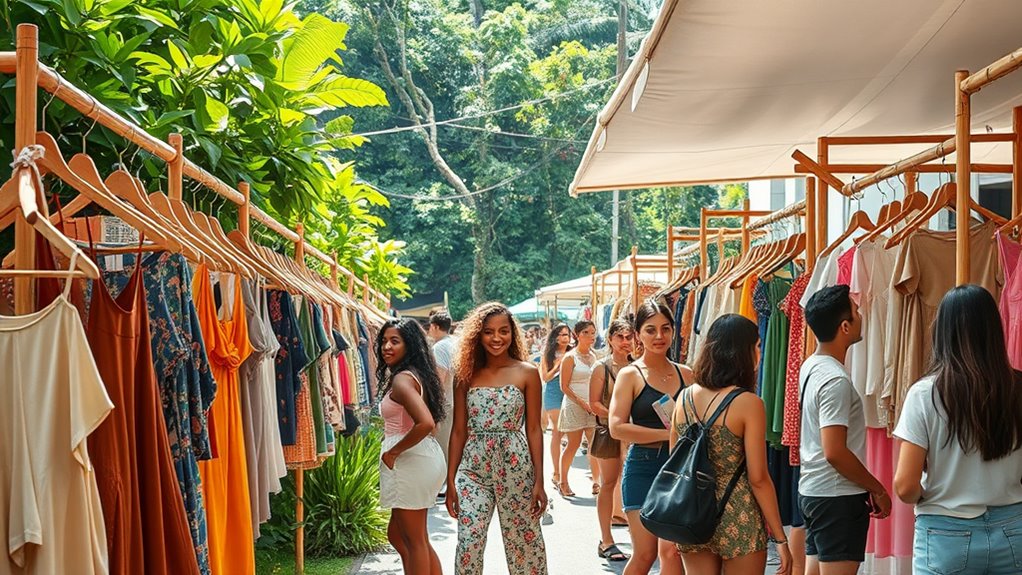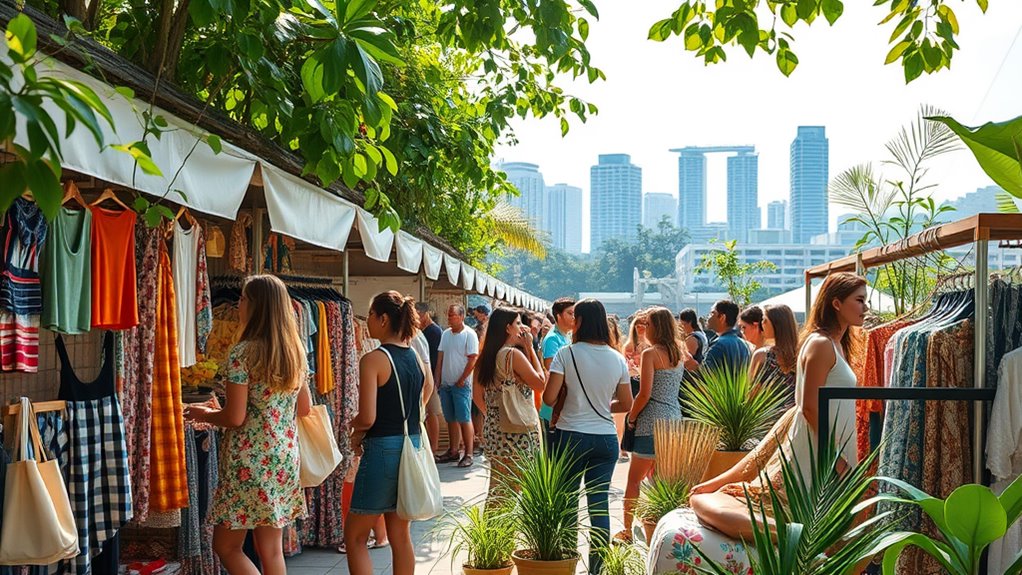When you're considering launching a sustainable fashion brand in Singapore, it's crucial to focus on the unique landscape that blends innovation with eco-consciousness. You'll want to investigate sustainable materials and ethical practices while also tapping into government support and local craftsmanship. Understanding the market dynamics and consumer behaviors can set your brand apart, but you'll need to navigate different challenges along the way. So, what key steps should you take to guarantee your brand not only stands out but thrives in this competitive environment?
Overview of Sustainable Fashion in Singapore
Sustainable fashion in Singapore is gaining traction as awareness of environmental issues grows. You're stepping into an exciting age where eco-friendly practices are becoming more than just a trend—they're a movement.
With the fashion industry projected to grow at an annual rate of 4.1% from 2020 to 2025, you can feel the surge of interest in sustainable solutions. Yet, consider this: Singapore generates around 168,000 tonnes of textile waste annually. That's a call to action!
While only 25% of consumers are willing to pay more for eco-friendly products, don't let that discourage you. It's a challenge waiting for creative minds like yours to overcome.
Collaborating with like-minded businesses and engaging consumers can ignite awareness and shift perceptions about sustainable fashion's value.
Imagine creating pieces that not only look fabulous but also contribute to a cleaner planet. Your path will be about more than just style; it'll be a celebration of freedom—freedom to express your values through what you wear.
Seize the opportunity to lead by example and inspire others to join the sustainable fashion revolution. It's time to liberate fashion from its wasteful past!
Government Support and Initiatives
As you commence your sustainable fashion adventure in Singapore, you'll find that government support plays a pivotal role in fostering an eco-friendly landscape.
The Sustainable Singapore Blueprint, launched in 2015, provides a solid framework, aiming to reduce waste and improve recycling efforts in the fashion industry. This initiative not only guides businesses but also inspires you to think creatively about sustainability.
You'll uncover that government agencies must consider environmental impacts when making textile purchases. This promotes accountability and encourages your brand to rise to the occasion.
Financial incentives like the Enterprise Development Grant (EDG) are available, making it easier for you to adopt sustainable practices without breaking the bank.
Moreover, the government actively launches public campaigns that educate consumers about the advantages of sustainable fashion. This rising awareness increases demand for eco-friendly products, creating a ripe market for your brand.
However, don't forget to consult with legal experts and utilize compliance management tools to guarantee you adhere to regulations while maintaining sustainable operations.
With the right support and knowledge, you can carve out your niche in this vibrant, eco-conscious community. Accept the challenge and let your creativity flourish!
Sustainable Practices and Materials

The expedition to establishing your sustainable fashion brand in Singapore hinges on the thoughtful selection of materials and practices that prioritize the planet. Embracing eco-friendly materials like organic cotton, bamboo, and recycled fabrics can notably minimize your environmental impact.
These choices not only feel good but also resonate with consumers longing for liberation from the fast fashion cycle.
Consider adopting the circular fashion model, which promotes reuse, recycling, and upcycling. By designing for longevity, you help address the staggering 168,000 tonnes of textile waste produced annually in Singapore.
This approach encourages responsible consumer behavior, transforming your brand into a guiding light of sustainability.
Transparency in your supply chain is essential. Regular audits and public reporting can help you identify and eliminate unethical practices, fostering a more conscious fashion ecosystem.
Partner with local initiatives that improve textile recycling efforts, and watch your brand flourish in a community enthusiastic for change.
Ethical Manufacturing Standards
Building a sustainable fashion brand in Singapore involves not just eco-friendly materials but also a commitment to ethical manufacturing standards. You must guarantee fair wages, reasonable working hours, and safe working conditions for all workers involved in your production process. This commitment will set you apart and resonate with conscious consumers.
Here's a quick overview of key ethical manufacturing elements:
| Element | Description | Importance |
|---|---|---|
| Fair Wages | Pay workers a living wage | Supports livelihoods and economic stability |
| Safe Working Conditions | Guarantee a hazard-free environment | Protects workers' health and well-being |
| Supply Chain Transparency | Regular audits and public reporting | Builds trust with consumers |
| Environmental Compliance | Adhere to waste management and emissions laws | Reduces environmental impact |
| NGO Collaboration | Partner with ethical NGOs for fair labor practices | Empowers artisans and fosters community growth |
Marketing and Branding Strategies

Effective marketing and branding strategies are crucial for any sustainable fashion brand aiming to resonate with consumers.
In a world increasingly aware of fashion's environmental impact, you can carve out your niche by embracing transparency and authenticity.
Here are three key strategies to amplify your voice:
- Tell Your Story: Share the cultural and ethical narratives behind your designs. Consumers want to connect with brands that reflect their values and mission.
- Engage with Your Community: Utilize social media platforms to educate and inspire. Host local events or workshops that invite eco-conscious individuals to learn and participate, building a loyal following.
- Collaborate Wisely: Partner with like-minded influencers or local artisans. This not only boosts your visibility but also reinforces your commitment to sustainability.
Challenges in the Sustainable Sector
Maneuvering the sustainable fashion sector presents a range of challenges that can deter new brands. With high costs associated with sourcing sustainable materials, small businesses often find themselves competing against established giants, making it tough to carve out a niche.
| Challenge | Impact |
|---|---|
| High material costs | Limits accessibility for newcomers |
| Consumer awareness | Only 25% willing to pay more for eco-friendly products |
| Textile waste | 168,000 tonnes produced annually in Singapore |
| Supply chain issues | Hinders efficiency and sustainable operations |
Additionally, the staggering 168,000 tonnes of textile waste produced yearly emphasizes the urgent need for creative practices. Yet, with limited consumer awareness, your mission to promote sustainable options might feel like swimming upstream. High operational costs and fierce competition further complicate your path, creating intimidating barriers to entry.
Despite these hurdles, your vision for a more sustainable future can inspire others to join the movement. You'll face challenges, but every step you take toward liberation in fashion can spark change. Welcome the struggle, and remember, every effort counts in reshaping the industry for the better.
Entrepreneurial Opportunities and Trends

Seizing the moment in Singapore's sustainable fashion market offers exciting entrepreneurial opportunities that are hard to ignore.
With an annual growth rate of 4.1% projected until 2025, the demand for eco-friendly products is booming. Approximately 80% of consumers want more sustainable options in fashion, indicating a clear path for your brand to thrive.
Here are three key trends to contemplate:
- Innovative Business Models: Investigate clothing rental and subscription services. These options not only appeal to eco-conscious consumers but also promote a circular economy.
- Local Collaborations: Team up with local artisans and communities. This approach not only improves your brand's authenticity but also celebrates traditional craftsmanship, allowing you to offer unique products that resonate with your audience.
- Government Support: Utilize initiatives like the Sustainable Singapore Blueprint. The financial incentives and support available can help you kickstart your business while embracing sustainable practices.
Financial Planning for Startups
Financial planning plays a crucial role in the success of your sustainable fashion startup in Singapore. To navigate the complexities of sourcing eco-friendly materials, you'll need a well-structured budget that accounts for different startup costs. Think about business registration, marketing, and the unique expenses of sustainable sourcing, all of which will greatly impact your initial investments.
Here's a simple breakdown to help you visualize your expenses:
| Expense Category | Estimated Cost | Notes |
|---|---|---|
| Business Registration | $300 | Vital for legal setup |
| Marketing | $1,000 | Build your brand presence |
| Sustainable Materials | $2,500 | Quality over quantity matters |
| Miscellaneous | $700 | Keep some flexibility |
Don't forget to investigate financial incentives and grants, like the Enterprise Development Grant (EDG), which can ease your financial burdens. Regularly tracking Key Performance Indicators (KPIs) related to expenses and revenue will guarantee you're on the right path. Collaborate with financial advisors to improve your operational efficiency, paving a way for your brand's success while staying true to your sustainable vision. With careful planning, you can achieve liberation in both your finances and your mission!
Digital Integration and E-commerce

As you establish your sustainable fashion brand in Singapore, integrating digital tools and e-commerce into your strategy can greatly augment your reach and efficiency.
In the current market, where 63% of consumers research online before making a purchase, a strong digital presence isn't just an option—it's vital.
Here are three key strategies to elevate your e-commerce approach:
- User-Friendly E-Commerce Platforms: Choose platforms that allow you to easily showcase your eco-friendly products, making the shopping experience seamless and enjoyable for your customers.
- Leverage Technology: Integrate AI and blockchain to enhance supply chain transparency. This not only guarantees ethical sourcing but also communicates your commitment to sustainability to your audience.
- Optimize for Search Engines: Implement SEO strategies to boost your search rankings. This brings more visibility to your brand and attracts eco-conscious consumers who share your values.
Frequently Asked Questions
How to Promote Sustainability in Singapore?
To promote sustainability in Singapore, you can utilize government initiatives, engage consumers through awareness campaigns, collaborate with local artisans, utilize social media for education, and implement circular fashion practices that inspire conscious choices and reduce waste.
How Do You Make a Fashion Brand Sustainable?
You're weaving a tapestry of change; choose eco-friendly materials, uphold ethical practices, and adopt circular fashion. Let transparency guide you, and together we'll break the chains of waste, creating a liberated, sustainable future in fashion.
Do Singaporeans Care About Sustainable Fashion?
Yes, Singaporeans care about sustainable fashion. Many crave eco-friendly options but hesitate to pay more. By educating and empowering consumers, you can bridge that gap, inspiring a shift towards a more sustainable, liberated fashion culture.
What Is the Singapore Action Plan for Sustainable Fashion?
Imagine a garden flourishing with eco-conscious choices; that's the Singapore Action Plan for Sustainable Fashion. It nurtures collaboration, educates communities, and equips the workforce, all while guiding you toward a greener, more responsible fashion future.
Conclusion
Launching a sustainable fashion brand in Singapore is like planting a seed in fertile soil; with the right practices, it can blossom into something remarkable. By embracing eco-friendly materials, ethical manufacturing, and creative marketing, you'll not only captivate consumers but also contribute to a brighter future. Remember, each step you take builds a path toward sustainability, inviting others to join your expedition. So, roll up your sleeves, and let your passion for fashion pave the way for change!
